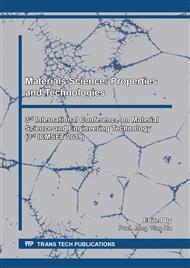[1]
Y. Huang, J. Liang, Y. Chen, An overview of the applications of graphene‐based materials in supercapacitors, Small, 8(12) (2012) 1805-1834.
DOI: 10.1002/smll.201102635
Google Scholar
[2]
C. Largeot, C. Portet, J. Chmiola, P. L. Taberna, Y. Gogotsi, P. Simon, Relation between the ion size and pore size for an electric double-layer capacitor, J. Am. Chem. Society, 130(9) (2008) 2730-2731.
DOI: 10.1021/ja7106178
Google Scholar
[3]
J. T. Mefford, W. G. Hardin, S. Dai, K. P. Johnston, K. J. Stevenson, Anion charge storage through oxygen intercalation in LaMnO3 perovskite pseudocapacitor electrodes, Nat. Mater. 13 (2014) 726-732.
DOI: 10.1038/nmat4000
Google Scholar
[4]
J. Xu, T. Ding, J. Wang, J. Zhang, S. Wang, C. Chen et al. Tungsten oxide nanofibers self-assembled mesoscopic microspheres as high-performance electrodes for supercapacitor, Electrochimica Acta, 174 (2015) 728-734.
DOI: 10.1016/j.electacta.2015.06.044
Google Scholar
[5]
M. Deepa, A. K. Srivastava, K. N. Sood, S. A. Agnihotry, Nanostructured mesoporous tungsten oxide films with fast kinetics for electrochromic smart windows, Nanotechnol. 17(10) (2006) 2625-2630.
DOI: 10.1088/0957-4484/17/10/030
Google Scholar
[6]
J. Y. Zheng, Z. Haider, T. K. Van, A. U. Pawar, M. J. Kang, C. W. Kim, Y. S. Kang, Tuning of the crystal engineering and photoelectrochemical properties of crystalline tungsten oxide for optoelectronic device applications, CrystEngComm, 17(32) (2015) 6070-6093.
DOI: 10.1039/c5ce00900f
Google Scholar
[7]
B. Sarma, A. L. Jurovitzki, Y. R. Smith, S. K. Mohanty, M. Misra, Redox-induced enhancement in interfacial capacitance of the titania nanotube/bismuth oxide composite electrode, ACS Appl. Mater. Interf. 5 (2013) 1688-1697.
DOI: 10.1021/am302738r
Google Scholar
[8]
S. Ratha, and C. S. Rout, Supercapacitor electrodes based on layered tungsten disulfide-reduced graphene oxide hybrids synthesized by a facile hydrothermal method, ACS Appl. Mater. Interfaces, 5(5) (2013) 1688-1697.
DOI: 10.1021/am403663f
Google Scholar
[9]
T. Ohba, H. Kanoh, K. Kaneko, Facilitation of water penetration through zero-dimensional gates on rolled-up graphene by cluster–chain–cluster transformations, J. Phys. Chem. 116(22) (2012) 12339-12345.
DOI: 10.1021/jp302769m
Google Scholar
[10]
P. Yang, X. Xiao, Y. Li, Y. Ding, P. Qiang, X. Tan, H. Jin et al. Hydrogenated ZnO core–shell nanocables for flexible supercapacitors and self-powered systems, ACS Nano, 7(3) (2013) 2617-2626.
DOI: 10.1021/nn306044d
Google Scholar


